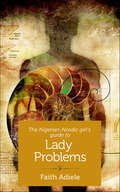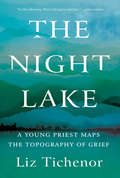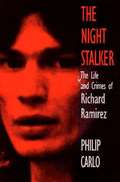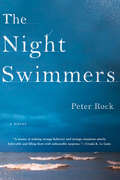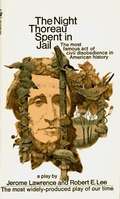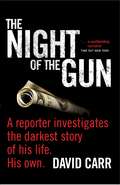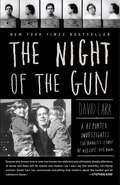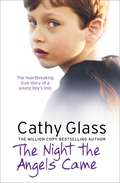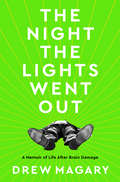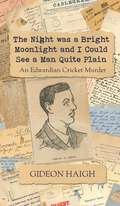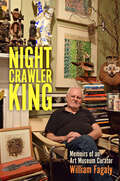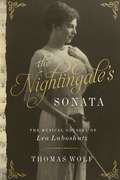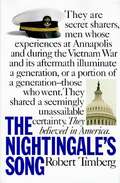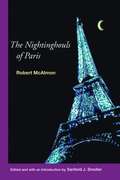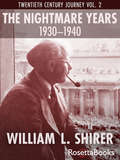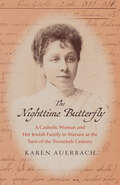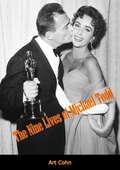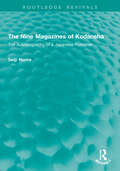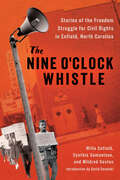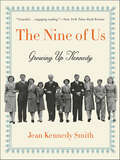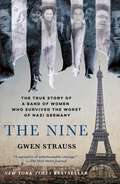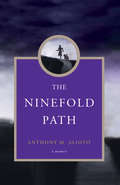- Table View
- List View
The Nigerian-Nordic Girl's Guide to Lady Problems
by Faith AdieleWhat’s a Nigerian-Nordic-American girl to do when she develops fibroids in rural Iowa? Battle the American health care system or summon Nordic mythology and traditional Nigerian medicine? While at the renowned Iowa Writers’ Workshop to write a book about meeting her African father and siblings as an adult, Faith Adiele develops a medical condition that can be interpreted—and treated— completely differently according to her three cultural backgrounds. Frustratingly, each tradition suggests that Adiele herself is responsible for her condition (and potential barrenness) for having violated gender or racial norms. While wittily detailing her struggles with doctors determined either to remove or to use her uterus as a Midwestern teaching tool, she draws parallels to history: her Nordic family’s immigration experiences, her Nigerian family’s independence struggles, and the fate of women, the poor, and folks of color in American medicine. Adiele takes a clear-eyed, sharp-tongued look at healing, from Western science to a good metaphor to Nigerian healers advertising the cure for “Lady Problems.”
The Night Chant: A Navaho Ceremony
by Washington MatthewsA detailed description of a nine-day Navajo ceremony of healing rites, songs, myths, and prayers performed only during "frosty weather" as observed by nineteenth century ethnologist and linguist Washington Matthews.
The Night Lake: A Young Priest Maps the Topography of Grief
by Liz TichenorCalled "such a sad, tough story, but finally so life-affirming, filled with spirit and love" by Anne Lamott, this is a raw and intensely affecting memoir by a young priest about loss of a child, its grief and its aftermath, and the hard-won joy that can follow.Liz Tichenor has taken her newborn son, five weeks old, to the doctor, from a cabin on the shores of Lake Tahoe. She is sent home to her husband and two-year-old daughter with the baby, who is pronounced "fine" by an urgent care physician. Six hours later, the baby dies in their bed. Less than a year and a half before, Tichenor's mother jumped from a building and killed herself after a long struggle with alcoholism. As a very young Episcopal priest, Tichenor has to "preach the Good News," to find faith where there is no hope, but she realizes these terrible parts of her own life will join her in the pulpit. The Night Lake is the story of finding a way forward through tragedies that seem like they might be beyond surviving and of carving out space for the slow labor of learning to live again, in grief.
The Night Parade: A Speculative Memoir
by Jami Nakamura LinA Most Anticipated Book by Poets & Writers • The Boston Globe • San Francisco Chronicle • Los Angeles Times • The Millions • Library Journal • Book Riot • Debutiful • and many more! In the groundbreaking tradition of In the Dream House and The Collected Schizophrenias, a gorgeously illustrated speculative memoir that draws upon the Japanese myth of the Hyakki Yagyo—the Night Parade of One Hundred Demons—to shift the cultural narrative around mental illness, grief, and remembrance. “Jami Nakamura Lin has reinvented the genre of memoir. . . . Serpentine, polyphonic, and stunningly textured, The Night Parade positively pulses with life." — Alex Marzano-Lesnevich, award-winning author of The Fact of a Body Are these the only two stories? The one, where you defeat your monster, and the other, where you succumb to it?Jami Nakamura Lin spent much of her life feeling monstrous for reasons outside of her control. As a young woman with undiagnosed bipolar disorder, much of her adolescence was marked by periods of extreme rage and an array of psychiatric treatments, and her relationships suffered as a result, especially as her father’s cancer grasped hold of their family.As she grew older and learned to better manage her episodes, Lin became frustrated with the familiar pattern she found in mental illness and grief narratives, and their focus on recovery. She sought comfort in the stories she’d loved as a child—tales of ghostly creatures known to terrify in the night. Through the lens of the yokai and other figures from Japanese, Taiwanese, and Okinawan legend, she set out to interrogate the very notion of recovery and the myriad ways fear of difference shapes who we are as a people.Featuring stunning illustrations by her sister, Cori Nakamura Lin, and divided into the four acts of a traditional Japanese narrative structure, The Night Parade is a genre-bending and deeply emotional memoir that mirrors the sensation of being caught between realms. Braiding her experience of mental illness, the death of her father, the grieving process, and other haunted topics with storytelling tradition, Jami Nakamura Lin shines a light into dark corners, driven by a question: How do we learn to live with the things that haunt us?
The Night Stalker: The True Story of America's Most Feared Serial Killer
by Philip CarloBased on hours of interviews with Ramirez on California's Death Row, a chilling account of the crimes of the "Night Stalker" follows Ramirez's criminal odyssey, from his first brush with the law, to his Los Angeles murder spree, to the investigation that brought him to justice.
The Night Swimmers
by Peter Rock“Swimming at night, to compare its slipperiness to that of a dream would be to ignore the work of staying afloat, the mesmerism brought on by the rhythm, the repetition of the strokes.” Beneath the surface of Lake Michigan there are vast systems: crosscutting currents, sudden drop-offs, depths of absolute darkness, shipwrecked bodies, hidden places. Peter Rock’s stunning autobiographical novel begins in the ’90s on the Door Peninsula of Wisconsin. The narrator, a recent college graduate, and a young widow, Mrs. Abel, swim together at night, making their way across miles of open water, navigating the currents and swells and carried by the rise and fall of the lake. The nature of these night swims, and of his relationship to Mrs. Abel, becomes increasingly mysterious to the narrator as the summer passes, until the night that Mrs. Abel disappears. Twenty years later, the narrator—now married with two daughters—tries to understand those months, his forgotten obsessions and dreams. Digging into old notebooks and letters, as well as clippings he’s preserved on the “psychic photography” of Ted Serios and scribbled quotations from Rilke and Chekhov, the narrator rebuilds a world he’s lost. He also looks for clues to the fate of Mrs. Abel, and begins once again to swim distances in dark water.
The Night Thoreau Spent in Jail
by Robert E. Lee Jerome Lawrence"If the law is of such nature that it requires you to be an agent of injustice to another, then I say, break the law." In 1849, the young Henry David Thoreau, philosopher, poet, naturalist, penned these timeless words in his book Civil Disobedience.
The Night of the Gun
by David Carr"New York Times" reporter and columnist Carr crafts a groundbreaking memoir on his years as an addict. Built on more than 50 videotaped interviews with people from his past, Carr's investigation of his own history reveals a past far more harrowing than he allowed himself to remember.
The Night of the Gun: A reporter investigates the darkest story of his life. His own.
by David CarrFrom David Carr (1956–2015), the “undeniably brilliant and dogged journalist” (Entertainment Weekly) and author of the instant New York Times bestseller that the Chicago Sun-Times called “a compelling tale of drug abuse, despair, and, finally, hope.”Do we remember only the stories we can live with? The ones that make us look good in the rearview mirror? In The Night of the Gun, David Carr redefines memoir with the revelatory story of his years as an addict and chronicles his journey from crack-house regular to regular columnist for The New York Times. Built on sixty videotaped interviews, legal and medical records, and three years of reporting, The Night of the Gun is a ferocious tale that uses the tools of journalism to fact-check the past. Carr’s investigation of his own history reveals that his odyssey through addiction, recovery, cancer, and life as a single parent was far more harrowing—and, in the end, more miraculous—than he allowed himself to remember. Fierce, gritty, and remarkable, The Night of the Gun is “an odyssey you’ll find hard to forget” (People).
The Night the Angels Came
by Cathy GlassEight year old Michael is part of a family of two, but with his beloved father given only months to live and his mother having died when he was a toddler, he could soon become an orphan. Will Cathy's own young family be able to handle a child in mourning? To Cathy's surprise, her children insist that this boy deserves to be as happy as they are, prompting Cathy to welcome Michael into her home. A cheerful and carefree new member of the family, Michael devotedly prays every night, believing that when the time is right, angels will come and take his Daddy to be with his Mummy in heaven. However, incredibly, in the weeks that pass, the bond between Cathy's family, Michael and his kind and loving father Patrick grows. Even more promising, Patrick is looking healthier than he's done in weeks. But just as they are settling into a routine of blissful normality, an unexpected and disastrous event shatters the happy group, shaking Cathy to the core. Cathy can only hope that her family and Michael's admirable faith will keep him strong enough to rebuild his life.
The Night the Lights Went Out: A Memoir of Life After Brain Damage
by Drew MagaryA fascinating, darkly funny comeback story of learning to live with a broken mind after a near-fatal traumatic brain injury—from the acclaimed author of The Hike&“Drew Magary has produced a remarkable account of his journey, one that is filled with terror, tenderness, beauty, and grace.&”—David Grann, bestselling author of Killers of the Flower Moon Drew Magary, fan-favorite Defector and former Deadspin columnist, is known for his acerbic takes and his surprisingly nuanced chronicling of his own life. But in The Night the Lights Went Out, he finds himself far out of his depths. On the night of the 2018 Deadspin Awards, he suffered a mysterious fall that caused him to smash his head so hard on a cement floor that he cracked his skull in three places and suffered a catastrophic brain hemorrhage. For two weeks, he remained in a coma. The world was gone to him, and him to it. In his long recovery from his injury, including understanding what his family and friends went through as he lay there dying, coming to terms with his now permanent disabilities, and trying to find some lesson in this cosmic accident, he leaned on the one sure thing that he knows and that didn't leave him—his writing.Drew takes a deep dive into what it meant to be a bystander to his own death and figuring out who this new Drew is: a Drew that doesn't walk as well, doesn't taste or smell or see or hear as well, and a Drew that is often failing as a husband and a father as he bounces between grumpiness, irritability, and existential fury. But what's a good comeback story without heartbreak? Eager to get back what he lost, Drew experiences an awakening of a whole other kind in this incredibly funny, medically illuminating, and heartfelt memoir.
The Night was a Bright Moonlight and I Could See a Man Quite Plain: An Edwardian Cricket Murder
by Gideon HaighGideon Haigh has written numerous acclaimed books on both cricket and true-crime – now he&’s unearthed a gripping story that combines the two, in a masterpiece of historical detective work that ties back to the origin of the Ashes … On the night of 23 September 1910, on a station 500km west of Brisbane, farm hand John Neil was beaten to death with a cricket bat. The prime suspect, George Vernon, was the fresh-faced twenty-four-year-old son of one of England&’s most famous amateur cricketers, and part of an Australian rural dynasty. The murder trial became one of Queensland&’s most sensational, for Vernon did indeed harbour a secret – but not a secret anyone suspected. And the crime was to have a shocking sequel. The Night was a Bright Moonlight and I Could See a Man Quite Plain concerns a brutal murder, but also the dark parts of empire, the blind side of justice and the sensational end of media – all linked back to the origin story of cricket&’s Ashes. Sparely written and copiously illustrated, it will keep you guessing to the end.
The Nightcrawler King: Memoirs of an Art Museum Curator (Willie Morris Books in Memoir and Biography)
by William FagalyWhile growing up in rural Indiana during World War II, William Fagaly began his first venture—collecting and selling earthworms to locals—from which he was christened with a childhood moniker. The Nightcrawler King: Memoirs of an Art Museum Curator is a narrative of Fagaly’s life told in two parts: first, his childhood experiences and, second, his transformation into an adult art museum curator and administrator in Louisiana. With a career that coincided with the dramatic growth of museums in the United States, Fagaly adds a unique perspective to New Orleans history, which highlights Louisiana history and establishes how it resonates around the nation and world. Offering a rare and revealing inside look at how the art world works, Fagaly documents his fifty years of experience of work—unusually spent at a single institution, the New Orleans Museum of Art. During this past half century, he played an active role in the discovery and appreciation of new areas of art, particularly African, self-taught, and avant-garde contemporary. He organized numerous significant art exhibitions that traveled to museums across the country and authored the accompanying catalogs. Fagaly’s cherished memories and the wonderful people who have touched his life are showcased in this memoir—friends, family, university professors, museum colleagues, art historians, visual artists, musicians, art dealers, art collectors, patrons, and partners—even his cats.
The Nightingale's Sonata: The Musical Odyssey Of Lea Luboshutz
by Thomas WolfA moving and uplifting history set to music that reveals the rich life of one of the first internationally renowned female violinists Spanning generations, from the shores of the Black Sea to the glittering concert halls of New York, The Nightingale's Sonata is a richly woven tapestry centered around violin virtuoso Lea Luboshutz. Like many poor Jews, music offered an escape from the prejudices that dominated society in the last years of the Russian Empire. But Lea’s dramatic rise as an artist was further accentuated by her scandalous relationship with the revolutionary Onissim Goldovsky. As the world around them descends in to chaos, between revolution and war, we follow Lea and her family from Russia to Europe and eventually, America. We cross paths with Pablo Casals, Isadora Duncan, Emile Zola and even Leo Tolstoy. The little girl from Odessa will eventually end up as one of the founding faculty of the prestigious Curtis Institute of Music, but along the way she will lose her true love, her father, and watch a son die young. The Iron Curtain would rise, but through it all, she plays on. Woven throughout this luminous odyssey is the story is César Franck’s “Sonata for Violin and Piano," a work championed by Lea, one of the first-ever internationally recognized female violinists. It became a touchstone for her, for her multi-generational family of musicians, and for scores of her students who played this masterwork throughout the world.
The Nightingale's Song
by Robert TimbergA terrific book about courage and cowardice, honor and betrayal, suffering and death, and the indomitability of the human spirit.
The Nightinghouls of Paris
by Robert Mcalmon Sanford J. SmollerThe Nightinghouls of Paris is a thinly fictionalized memoir of the darker side of expatriate life in Paris. Beginning in 1928, the story follows the changes undergone by Canadian youths John Glassco and his friend Graeme Taylor during their (mis)adventures in Paris while trying to become writers. There they meet Robert McAlmon, who guides them through the city's cafes, bistros, and nightclubs, where they find writers and artists including Kay Boyle (with whom Glassco has a fling), Bill Bird, Djuna Barnes, Claude McKay, Hilaire Hiler, Peggy Guggenheim, and Ernest Hemingway. Fleeing France in late 1940, Robert McAlmon lost his notebook manuscripts and drafted The Nightinghouls of Paris from memory. Till now, it has existed solely as a typescript held by Yale University. Unlike most memoirs of American expatriates in the '20s, The Nightinghouls of Paris centers not only on writers, but also encompasses the racial, national, and social mélange they encountered in everyday life.
The Nightmare Years, 1930–1940 (Twentieth Century Journey #2)
by William L. ShirerThe famous journalist and author of The Rise and Fall of the Third Reich documents his front row seat at the pivotal events leading up to World War II. In the second of a three-volume series, William L. Shirer tells the story of his own eventful life, detailing the most notable moments of his career as a journalist stationed in Germany during the rise of the Third Reich. Shirer was there while Hitler celebrated his new domination of Germany, unleashed the Blitzkrieg on Poland, and began the conflict that would come to be known as World War II. This remarkable account tells the story of an American reporter caught in a maelstrom of war and politics, desperately trying to warn Europe and the United States about the dangers to come. This memoir gives readers a chance to relive one of the most turbulent periods in twentieth century history—painting a stunningly intimate portrait of a dangerous decade. &“Mr. Shirer stirs the ashes of memory in a personal way that results in both a strong view of world events and of the need for outspoken journalism. Had Mr. Shirer been merely a bland &‘objective&’ reporter without passion while covering Hitler&’s Third Reich, this book and his other histories could never have been written.&” —The New York Times
The Nighttime Butterfly: A Catholic Woman and Her Jewish Family in Warsaw at the Turn of the Twentieth Century
by Karen AuerbachA dynamic history of life in turn-of-the-century Warsaw through the eyes of a young woman and her Jewish family who converted to Catholicism When Alicja Lewental’s parents came of age in the middle of the nineteenth century, they believed they did not have to choose between two communities, one Polish and the other Jewish. But by the time Alicja was growing up in the 1890s, it seemed that for some Polish nationalists there was little Jews could do to be accepted unequivocally as Poles. As Alicja entered young womanhood and her father, a prominent publisher, became the target of polemics casting him as an outsider in Polish culture, her mother came to believe that only through her daughters’ conversion to Catholicism and marriage to Catholic men could their family achieve acceptance in Polish society. The Lewentals’ lives and their aspirations for belonging played out in Warsaw’s homes, salons, and bookstores in a modernizing city. Drawing on Alicja Lewental’s diary and other sources, historian Karen Auerbach provides a unique window onto how the Lewentals and their circle navigated a time of increasing ambivalence about the possibility for Jewish belonging to the Polish nation. As exclusionary notions of what it meant to be Polish gained traction in politics, Alicja and her family encountered these ideas in their private lives.
The Nine Lives of Michael Todd: The Story Of One Of The Worlda¢â,¬â,¢s Most Fabulous Showmen
by Art CohnSHOW BIZ’ “LAST TYCOON”At eighteen he was president of a $2-million-a-year construction company. At twenty he couldn’t afford a house of his own.When he was thirty-seven he had four plays running simultaneously, netting him $20,000 a week. The following year he went into bankruptcy for over a million dollars.At forty-nine he married Hollywood’s reigning beauty, Elizabeth Taylor, and had the greatest hit in motion-picture history—Around the World in Eighty Days, the first motion picture likely to gross $100 million.Brash, flamboyant, half genius, half conman, he rose from the slums to giddy heights in the roller-coaster worlds of Broadway and Hollywood. Then, as in a script he might have written himself, he met death in a tragic plane crash—along with his biographer, the man who wrote this book.
The Nine Lives of Pakistan: Dispatches From A Precarious State
by Declan WalshA New York Times New Book to Watch For (November 2020) The former New York Times Pakistan bureau chief paints an arresting, up-close portrait of a fractured country. Declan Walsh is one of the New York Times’s most distinguished international correspondents. His electrifying portrait of Pakistan over a tumultuous decade captures the sweep of this strange, wondrous, and benighted country through the dramatic lives of nine fascinating individuals. On assignment as the country careened between crises, Walsh traveled from the raucous port of Karachi to the salons of Lahore, and from Baluchistan to the mountains of Waziristan. He met a diverse cast of extraordinary Pakistanis—a chieftain readying for war at his desert fort, a retired spy skulking through the borderlands, and a crusading lawyer risking death for her beliefs, among others. Through these “nine lives” he describes a country on the brink—a place of creeping extremism and political chaos, but also personal bravery and dogged idealism that defy easy stereotypes. Unbeknownst to Walsh, however, an intelligence agent was tracking him. Written in the aftermath of Walsh’s abrupt deportation, The Nine Lives of Pakistan concludes with an astonishing encounter with that agent, and his revelations about Pakistan’s powerful security state. Intimate and complex, attuned to the centrifugal forces of history, identity, and faith, The Nine Lives of Pakistan offers an unflinching account of life in a precarious, vital country.
The Nine Magazines of Kodansha: The Autobiography of a Japanese Publisher (Routledge Revivals)
by Seiji NomaThe Nine Magazines of Kodansha (1934) is the autobiography of the Japanese publisher Seiji Noma, owner of the Kodan Company, publishing several million-selling magazines and a daily paper. Born in 1878, Noma grew up in that period of rapid transition which joined old and new Japan – the wearing of swords by samurai had only been banned two years before his birth. Hereditary social divisions were collapsing, and the young Noma seized his opportunities to make his way in the new Japan.
The Nine O'Clock Whistle: Stories of the Freedom Struggle for Civil Rights in Enfield, North Carolina (Margaret Walker Alexander Series in African American Studies)
by Willa Cofield Cynthia Samuelson Mildred SextonBetween the years of 1963 and 1965, civil rights protests rocked rural communities like Enfield, a small North Carolina town where segregationist and white supremacist attitudes prevailed. Whites in Enfield enforced a variety of racist norms and employed a range of racist practices, including the sounding of a siren on Saturday nights meant to order Black residents to leave the downtown streets at nine o’clock. On August 28, 1963, hundreds of people, including Willa Cofield—an English teacher in the Black, segregated high school—and two of her students, Cynthia Samuelson and Mildred Sexton, protested these conditions as masses of Black people ignored the whistle.After firemen used high-powered water hoses to drive people off the streets, the Black community continued to resist by organizing a successful three-month boycott of the white-owned downtown stores. The movement quickly spread into the surrounding county, morphing into a voter registration campaign, a school integration effort, and a legal battle over author Willa Cofield’s First Amendment rights, after she was fired from her position as a public school teacher. The Nine O’Clock Whistle covers a range of historically and contextually significant stories, including details from Cofield’s grandfather’s early life as an enslaved person and her family’s rise to prominence in the Enfield Black community, to the roles the authors played in the local protest movement during the 1960s. Ultimately, Cofield, Samuelson, and Sexton squarely repudiate the assertion that the civil rights movement bypassed communities in northeastern North Carolina, and prove instead that the movement drastically changed the lives of people in towns like Enfield forever.
The Nine of Us: Growing Up Kennedy
by Jean Kennedy SmithIn this evocative and affectionate memoir, Ambassador Jean Kennedy Smith, the last surviving child of Joe and Rose Kennedy, offers an intimate and illuminating look at a time long ago when she and her siblings, guided by their parents, laughed and learned a great deal under one roof.Prompted by interesting tidbits in the newspaper, Rose and Joe Kennedy would pose questions to their nine children at the dinner table. "Where could Amelia Earhart have gone?" "How would you address this horrible drought?" "What would you do about the troop movements in Europe?" It was a nightly custom that helped shape the Kennedys into who they would become.Before Joe and Rose’s children emerged as leaders on the world stage, they were a loving circle of brothers and sisters who played football, swam, read, and pursued their interests. They were children inspired by parents who instilled in them a strong work ethic, deep love of country, and intense appreciation for the sacrifices their ancestors made to come to America. "No whining in this house!" was their father’s regular refrain. It was his way of reminding them not to complain, to be grateful for what they had, and to give back. In her remarkable memoir, Kennedy Smith—the last surviving sibling—revisits this singular time in their lives. Filled with fascinating anecdotes and vignettes, and illustrated with dozens of family pictures, The Nine of Us vividly depicts this large, close-knit family during a different time in American history. Kennedy Smith offers indelible, elegantly rendered portraits of her larger-than-life siblings and her parents. "They knew how to cure our hurts, bind our wounds, listen to our woes, and help us enjoy life," she writes. "We were lucky children indeed."
The Nine: The True Story of a Band of Women Who Survived the Worst of Nazi Germany
by Gwen StraussTHE BELOVED NEW YORK TIMES BESTSELLER"[A] narrative of unfathomable courage" ―Wall Street JournalThe Nine follows the true story of the author’s great aunt Hélène Podliasky, who led a band of nine female resistance fighters as they escaped a German forced labor camp and made a ten-day journey across the front lines of WWII from Germany back to Paris."I almost didn't finish this book. Not because it wasn't extraordinary—but because it was too extraordinary. Because somewhere around the third chapter, I realized I was holding my breath, terrified that if I exhaled too loudly, these nine women might disappear like smoke, like so many others did...They made promises to each other's children they'd never met, memorized addresses of families they might never find, carried letters for lovers who were probably already dead. They survived not in spite of love but because of it." —The Book NookThe nine women were all under thirty when they joined the resistance. They smuggled arms through Europe, harbored parachuting agents, coordinated communications between regional sectors, trekked escape routes to Spain and hid Jewish children in scattered apartments. They were arrested by French police, interrogated and tortured by the Gestapo. They were subjected to a series of French prisons and deported to Germany. The group formed along the way, meeting at different points, in prison, in transit, and at Ravensbrück. By the time they were enslaved at the labor camp in Leipzig, they were a close-knit group of friends. During the final days of the war, forced onto a death march, the nine chose their moment and made a daring escape.Drawing on incredible research, this powerful, heart-stopping narrative from Gwen Strauss is a moving tribute to the power of humanity and friendship in the darkest of times.
The Ninefold Path
by Anthony M. AliotoAnthony Alioto was diagnosed with end stage renal disease in 1993 and was forced to go on dialysis for several years before receiving a successful kidney transplant in 2000. "In The Ninefold Path," he invites readers to join him on a harrowing personal journey through a labyrinth of tests, OC what can I expectOCO meetings with medical staff, surgeries, and near-death experiences. He spares no detail in his desire to provide a guide for others living with a chronic disease OCo and their families and friends OCo on how to navigate the oftentimes rough waters of modern medicine. "The Ninefold Path" is for all of those wearily traveling through chronic illnesses and for those by their sides wondering what to do, it is a celebration of the extraordinary individuals in medicine who relieve the suffering of strangers each and every day. In cataloging detail, there is inspiration, plus a call to compassion and serenity. A Note to the Reader from "The Ninefold Path": OC The reader can expect to encounter a very personal and human account of chronic illness, sometimes painful, sometimes hilarious, and then at times simply absurd OCo but, hopefully, also moving. One need not search for profound insights, recipes, therapy, or sage advice. It is my hope that you will come away with a feeling, a sense of being there, maybe a kind of liberation from the OCymerely personalOCO as Einstein phrased it, and a new appreciation for what others endure daily. Even in the midst of suffering physical pain and mental anguish, a person may yet gain the freedom to live a life of celebration, joy, compassion, and serenity. Zen Master Kyong Ho once said, OCyDonOCOt hope for life without problems. An easy life results in a judgmental and lazy mind. OCOOCO"
